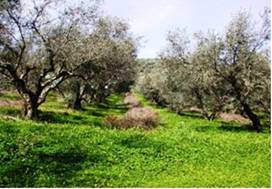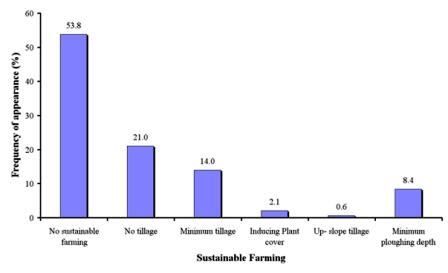Sustainable farming
Sustainable farming is defined as an agricultural system evolving towards greater human utility, increased efficiency of resource use, minimum depletion of non-renewable resources, and environmental interaction favourable to humans and to most other species. Sustainable farming may include actions such as: (a) land utilization schemes within the land capability limits, (b) no minimum tillage, (c) enhancing vegetation cover, (d) tillage of soil in the up-slope direction, (e) minimum depth of ploughing, etc (Fig 70). Minimum tillage may have favourable effects on soil aggregation and reduction of soil crusting and soil erosion. If the soil moisture level is optimal, a minimum tillage is generally favourable because the implements break up the clods, incorporate the organic matter into the soil, kill weeds, and create a more favourable seed bed. Therefore, tillage is considered necessary in the normal management of some soils. However, frequent tillage operations, especially those involving heavy equipments, have detrimental effects on surface soil degradation such as accelerating oxidation of soil organic matter, breaking down stable soil aggregates. Maximum soil degradation occurs when a soil is tilled with a mouldboard plough followed by several disking. In a no-till system, the residues are concentrated on the soil surface enhancing aggregate stability and protecting the soil from erosion. Enhancing vegetation cover comprises an effective sediment filter, usable in agricultural and other lands. Irregularly shaped and unproductive dry areas can be kept under natural vegetation for controlling runoff and sediment loss. The type of sustainable farming (if any) has been defined for each study field site by identifying the measures undertaken for sustainable farming as delineated.


Fig. 70. Examples of sustainable farming including no tillage (left) and minimum tillage-inducing plant cover (right)
Data for the indicator sustainable farming have been collected in 808 field sites, corresponding to 10 study sites. As Fig. 71 shows, no sustainable was defined in the majority of the study fields sites (53.8% of the total fields), corresponding to all field sites of Guadalentin Basin Murcia-Spain, Boteti Area-Botswana, Eskisehir-Turkey, Cointzio Catchment-Mexico, and Novij Saratov-Russia sites, and in some cases of Secano Interior-Chile, Mamora Sehoul-Morocco, and Zeuss Koutine-Tunisia sites. The next important action of sustainable farming was no tillage, defined in 21.0% of the study field sites. Such land management practice of sustainable farming has been identified in some cases in the study sites of Secano Interior-Chile, Santiago Island-Cape Verde, and Crete-Greece. Minimum tillage as sustainable farming has been found in 14.0% of the study field sites, corresponding to the study sites of Secano Interior-Chile, Santiago Island-Cape Verde, Mamora Sehoul-Morocco, Zeuss Koutine-Tunisia, and Crete-Greece. Minimum depth of plowing has been defined in 8.4% 0f the study field sites, corresponding to the study sites of Secano Interior-Chile, Mamora Sehoul-Morocco, and Zeuss Koutine-Tunisia. Finally, land management practices of sustainable farming inducing plant cover, and up-slope tillage have been defined in very few cases (Fig 71), corresponding in the study sites of Secano Interior-Chile, and Zeuss Koutine-Tunisia.

Fig. 71. Distribution of the various land management practices applied for sustainable farming in the study field sites